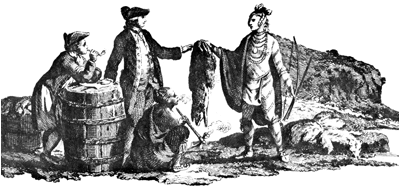Indians After Europeans
by George Sabo III This section summarizes the history of Arkansas Indians (Caddos, Cherokees, Osages, Quapaws, and Tunicas) after encounters with European explorers produced the first written descriptions of native communities. Following the departure of Soto’s army in 1543, more than a century passed before French explorers returned in 1673. Our story continues with the development of relations between the Indians and European colonists.
Indians and Colonists: The establishment of the Louisiana colony in the Mississippi Valley by La Salle in 1682 set in motion a series of events that cemented permanent relationships between American Indian communities and struggling Euroamerican settlements. Development of economic, social, political, and religious ties produced a new landscape of settlements reflecting a combination of Indian and European traditions. Caddo, Osage, Quapaw, and Tunica Indians became part of this landscape in the Arkansas region. Indians in the Old South: Expansion throughout the South of French, Spanish, and American colonies and the establishment of the United States marginalized Indian communities and led to ever-dwindling populations. Many Indian communities survived this era by joining together in new alliances, occupying new territories—resulting, for example, in the movement of many Cherokees into Arkansas—and pursuing subsistence opportunities at the edges of regional agricultural economies. Even so, events leading up to and following the American civil war imposed disastrous consequences for Southern Indians, including forced removal from homelands and resettlement in Indian Territory (in modern-day Oklahoma). There, Indians were subjected to United States policies designed to erase their cultural heritage and replace centuries-old traditions with rural American lifeways and values. Indians in the New South: Development of modern American social, political, and economic institutions resulted in the lifting of many overt forms of government oppression that Indians were forced to endure during the preceding era. Many groups, including Caddos, Cherokees, Osages, and Quapaws, adopted new constitutions and organized new forms of government when the United States restored some rights of self-determination with the Indian Reorganization Act of 1934. These developments led, in turn, to the resurgence of many long-suppressed cultural traditions. Indians Today: Modern American society is comprised of many “sub-cultures” or ethnicities, including American Indian cultures. Some American Indians are your neighbors, enjoying occupations as doctors, lawyers, teachers, and workers in numerous manufacturing and service industries. Other Indians reside in rural areas that once were part of nineteenth century reservations. In some of these areas today, the population is largely comprised of Indians who pursue livelihoods much like those of other rural Americans. Many tribal government complexes exist in these areas; for example, modern Caddo, Cherokee, Osage, and Quapaw government complexes are located in northeastern Oklahoma and the Tunica-Biloxi complex is located in Louisiana. These government complexes provide a home for programs designed to assist tribal members and preserve cherished institutions. Rural as well as urban Indians frequently gather at these complexes to celebrate their heritage and pass their traditions on to younger generations. |
||
 |

|
